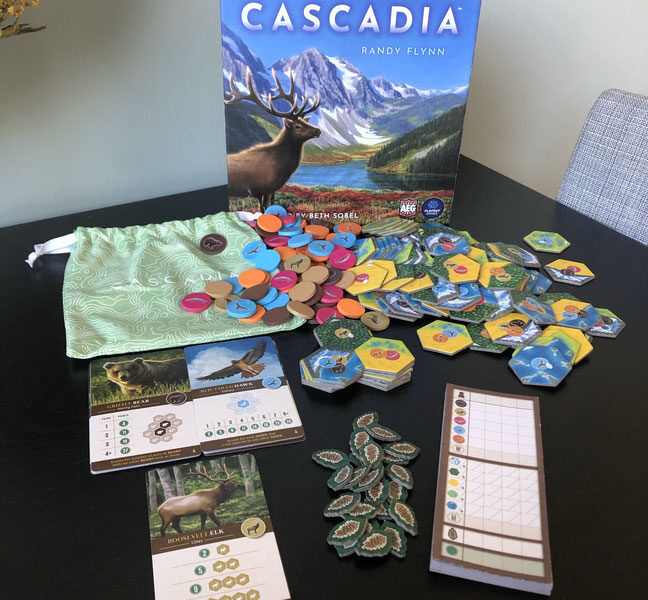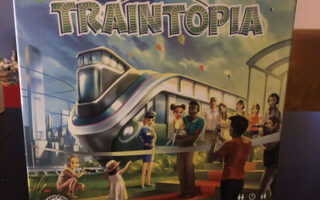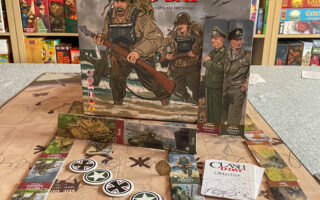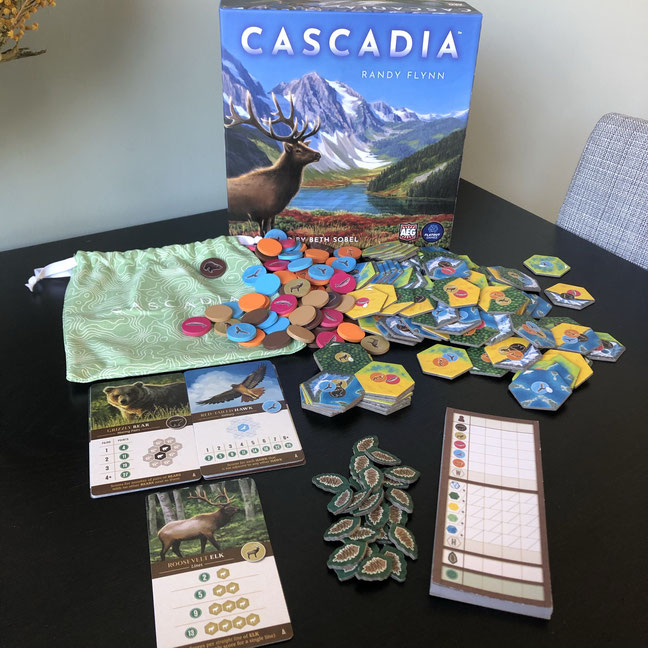
Game summary:
A game for 1 – 4 players
Play time 30 – 45 minutes
Designer: Kevin Russ
Artist: Beth Sobel
Publisher: Flatout Games & Alderac Entertainment Group
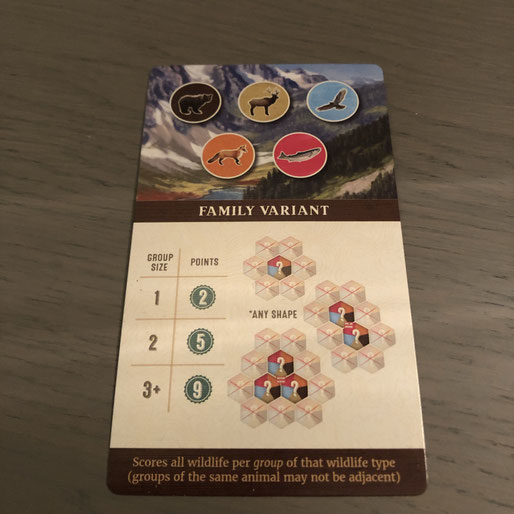
Unboxing
The box contains the following components:
Rulebook
85 Habitat tiles
100 Wildlife tokens
25 Nature tokens
5 Starter habitat tiles
21 Wildlife Scoring cards
1 Cloth bag
1 Scorepad
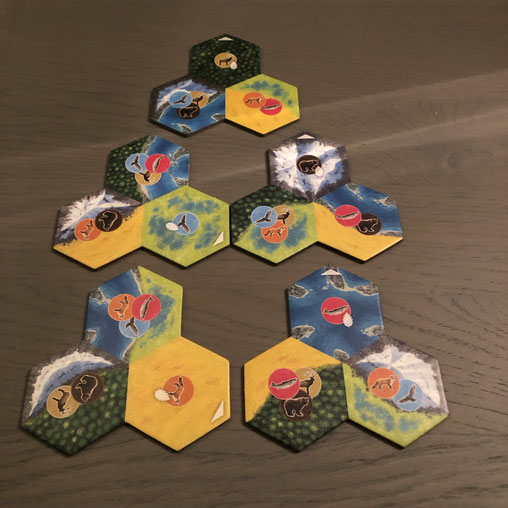
Here you see the five starter tiles. Every player receives one at the start of the game.
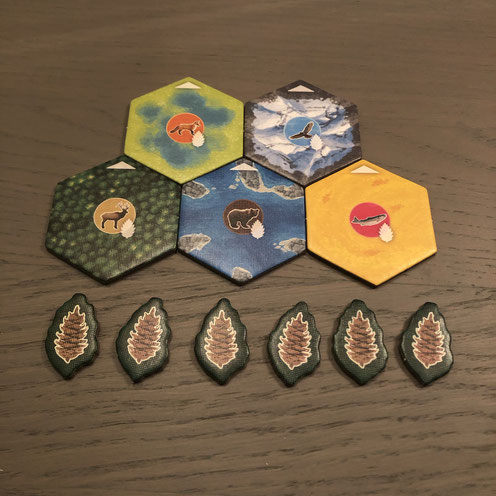
Here you see a few keystone tiles. When you place a corresponding token on the tile, you receive a Nature token.
Let’s get it to the table
Cascadia is a puzzly tile-laying and token-drafting game featuring the habitats & wildlife of the Pacific Northwest. Players will compete to create the most diverse Pacific Northwest environment when they draft habitat tiles and wildlife tokens to construct a beautiful landscape. Each game will be different by combinations of scoring objectives linked to each of the five wildlife species.
Player will also be competing the largest habitat corridors. When players build out their environment they may pay careful attention to the habitats they create and the wildlife they populate, with the goal of creating the most harmonious ecosystem in Cascadia
The player with the most points is the Master Quilter until the next game
First we’re going to setup the player boards and the table;
Let’s get the table ready.
Place all the wildlife tokens in the cloth bag and shuffle them well.
Now determine how many habitat tiles you need, based on the number of players. With 2 player you need 43, with 3 player you need 63 and with 4 players you need 83.
Shuffle these tiles as well and create a few stacks with these tiles (face down) in reach of all the players. The rest of the tiles can be placed back in the box.
Give every player random one starter habitat tile.
Now you can reveal 4 habitat tiles and place these in the middle of the table, beneath those tiles you can place 4 wildlife tokens from the bag and place them from left to right. They don’t need to match but you have now 4 pairs.
Place the nature tokens within reach of all the players.
Randomly select 1 Wildlife Scoring card for each of the five wildlife, then place those card in the play area so all player can see these cards. When you play for the first time, use the cards with the letter A on it. You can find more information about the different cards in the rulebook.
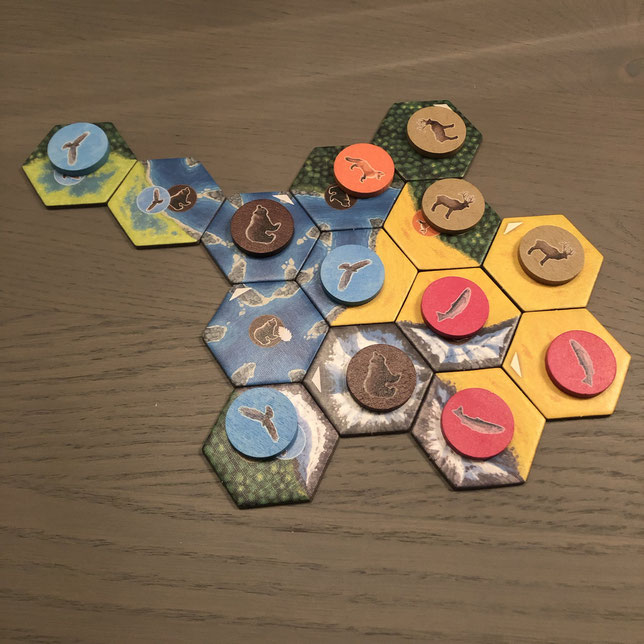
Now we are ready to play!
On each turn a player will select a habitat tile and a wildlife token combination and play them into their environment. At the end of each player’s turn, both the habitat tile and wildlife token will be replaced with new from the stack and the cloth bag.
Selecting a habitat tile and wildlife token
So at your turn there are 4 pairs with a habitat tile and a wildlife token. You select one of those pairs and take both of them and try to place the tile into your environment.
Once there are 3 identical tokens on the table, the player may replace these 3 with 3 other tokens. The respective tokens are then returned to the bag.
Once there are 4 identical tokens on the table, all 4 must be replaced. The respective tokens are then returned to the bag.
Placing the habitat tile and wildlife token into your environment
Once you’ve selected the habitat tile and token, you have to place it into your environment. This can be done in any order.
The tile has to be placed adjacent to any other tile and must touch at least one side of another tile or the starter habitat tile.
By placing this tile, try to see right away if this is the same area or not, because with this you can score points at the end of the game. But take a good look at the scoring cards because you can also use them to collect other points.
Placing a wildlife token
You have place a wildlife token on a single habitat tile, that tile must not already have a token on it. But that tile also must show the matching wildlife. This can be the same tile as you just placed from the play area or a different one.
In any case you can’t place the wildlife token, you have to place it into the bag with other wildlife tokens and shuffle the bag.
When you place the token on a keystone tile, you can also take a nature token. A keystone tile has an up arrow at the top of the tile but also the illustration of the nature tokens.
When you’ve placed the tile and token into your environment or placed the token into the bag, you replace each one in the center of the play area. Once everything is replenished, it is the next player’s turn.
Tile explanation
Some tiles has 2 types of terrain and also 2 different animals, on this tile you can place one of the 2 wildlife (animal) tokens. You can also use them to combine 2 types of terrains and create a longer habitat to score more points.
There are also tiles that are called keystone tiles, you can use these as follows. As soon as you place the matching wildlife token on them you will receive a nature token.
Using a Nature token
on your turn you can use a nature token, there are 2 things you can do with this token;
1. Take any of the four habitat tiles an any one of the four wildlife tokens.
2. Wipe any number of wildlife tokens and replace them.
There is no limit on the number of times you use a nature token during your turn. You can use al of the tokens you’ve collected.
Each nature token that you haven’t spend is worth 1 point.
Wildlife Scoring cards
During each game there are also 5 Wildlife Scoring cards on the table. On each of these cards you see how you can score points for each of the five wildlife.

A few examples of the scoring cards, on the right bottom you see a letter. In this case every card belongs to letter B and you can find an explanation in the rulebook.

The family card, you can use this when you play it for the first time or when you have new people that want to learn about boardgames.
End of the game
The game ends when there are no more habitat tiles available to replace one that has been selected by a player. All players have played exactly 20 turns. Then you’re going to count points, use the scorepad to record them.
You can score points for:
1. Wildlife Scoring cards; each player score points based on the scoring cards.
2. Habitat tiles corridors; each player score 1 point per habitat tile in their largest contiguous habitat corridor in each of the 5 habitats (mountains, forests, prairies, wetlands and rivers).
3. Habitat tiles corridors majorities; The player with the largest corridor also score extra points per habitat.
– In a solo game it’s 2 points for a group of 7 habitats or more;
– In a 2 player game 2 points and;
– In a 3/4 player game, 3 points for the largest and 1 point for the second largest.
4. Nature tokens; 1 point for each unused token.
The player with the most points is the winner of Cascadia!
Final Conclusion & rating:
Weight: 2.01 / 5
Replayability: 8
My rating: 🎲 🎲 🎲 🎲 🎲 🎲 🎲 🎲
Quality of the components
The quality of the components that they used are really great! The tiles are made from great quality and also the artwork is simple but really beautiful! The wildlife tokens are made from nice wooden (I think) quality and the feel nice, not to heavy like the stones for Azul or other games like that. but that’s not necessary for this game either, because you have to place them onto the tiles and see what’s beneath the token is.
The artwork on the cards is really impressive, sometimes they just look like photo’s. The way in which you can score points is clearly stated by means of pictures but sometimes you miss something in the explanation. Fortunately, this is solved in the game rules, where there is an extensive explanation and after some time you know what is meant. But in the beginning the extra explanation can be useful.
The rules are well explained with good examples and that makes it very clear. The rules do not really go into the use of the cards while playing Cascadia, I found that a bit of a miss.
Overall impression of the game
If I had to describe Cascadia, it would be that this is a very colorful and fun game. The colors they’ve used in the game make it a very cheerful game, you have to create a Pacific Northwest environment as beautiful as possible. It is very diverse in that the starting tiles can be different each time, but also the use of the scoring cards. In addition, you do not know which tiles and tokens will be on the table and that makes it a game with a high re-playability. Cascadia is a game I like to put on the table, it is a fast and beautiful game. I really like the fact that you don’t know what will come on the table, neither of the tiles nor of the tokens and therefore you always have to puzzle over which way to go. Of course, you are also dependent on the other players. Which tiles and tokens will they choose and will they also place a nature token?
Cascadia can also be played solo and I was very curious to see how that turned out. The rules are very simple but very fun and you must try to finish as high as possible in terms of points and I can tell you that is quite a challenge. During play, the rightmost token and tile are removed from the playing field, then everything moves to the right and a new pair is added. This game also ends after 20 turns.
There are also Achievements in the rules so you can play to perhaps become a Cascadian biologist.
Finally, there is also a family variant that you can play, eg with new board game friends or if you first want to play this game with children. Here you can use 1 card and score points for each wildlife in the same way.
As you can see, this is a very varied game with a high re-playability. That makes Cascadia a really nice game to have on your game shelf!
I want to thank AEG Games for this review copy, my opinion is not been affected by this.
